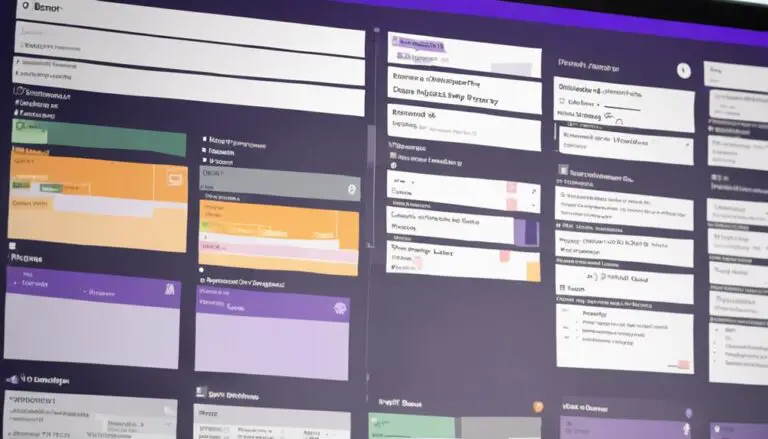When considering Kanban methodologies, you might wonder, does Kanban incorporate sprint planning? The integration of these two concepts can offer a unique perspective on optimizing workflow and enhancing project management efficiency.
By understanding how sprint planning can be adapted in a Kanban framework, you can unlock new possibilities for streamlining processes and achieving better outcomes.
Dive into the nuances of this comprehensive guide to uncover the intricacies of this hybrid approach and its potential impact on your project management strategies.
Key Takeaways
- Kanban doesn't have traditional sprints but employs flow-based planning techniques.
- Collaborate with team members to set time limits and visualize workflow progress.
- Utilize Kanban boards to track tasks and limit work in progress effectively.
- Enhance teamwork, communication, and productivity by integrating sprint planning principles in Kanban.
Understanding Kanban Methodology
When diving into the realm of Kanban methodology, visualize workflow through Kanban boards to seamlessly manage tasks and optimize performance. Kanban, unlike Sprint planning in Scrum, focuses on limiting work in progress to enhance efficiency.
In the context of Scrum and Kanban, the Kanban Guide for Scrum Teams can serve as a valuable resource. During a Sprint Planning session, the product owner collaborates with the team to select product backlog items for the next sprint. This meeting uses flow metrics to guide the team in prioritizing work items effectively.
Understanding Kanban methodology involves grasping the concept of breaking down projects into manageable tasks and tracking progress through visual boards. It emphasizes adaptability and continuous improvement, making it a suitable choice for teams looking to enhance their workflow processes.
Incorporating Sprint Planning in Kanban
To enhance your Kanban workflow, integrate Sprint planning by setting specific time limits for completing tasks within a Sprint period. This collaborative approach involves Scrum team members coming together to plan and prioritize work on a Kanban board. By visualizing workflow progress, you can effectively track tasks and ensure a steady flow of work.
Here are some key points to consider when incorporating Sprint planning in Kanban:
- Utilize flow-based metrics: Measure performance using metrics like Work In Progress (WIP), cycle time, and throughput to evaluate team efficiency.
- Enhance collaboration: Foster teamwork and communication among Scrum team members to improve task coordination and overall productivity.
- Optimize Kanban system: Integrate Sprint planning seamlessly into your Kanban system to streamline processes and achieve higher levels of efficiency.
Differences Between Kanban and Scrum
In understanding the distinctions between Kanban and Scrum, it becomes evident that their core methodologies diverge in approach and application. Kanban methodology focuses on continuous workflow optimization, managing tasks through visual Kanban boards, and limiting work in progress (WIP) to optimize flow.
On the other hand, the Scrum Framework utilizes time-boxed iterations called sprints, with fixed durations for task completion, emphasizing working deliverables for testing and feedback. While Kanban isn't time-bound, allowing for flexibility in task management, Scrum sets specific time frames for task completion.
Kanban emphasizes visual management and a pull system, whereas Scrum's Sprint Planning meeting involves creating a Sprint Backlog based on throughput data. Integrating Kanban and Scrum can combine the benefits of visualizing workflow with structured sprint planning, enhancing team productivity and adaptability.
Understanding these differences can help teams choose the most suitable approach for their specific needs and goals.
Implementing Sprint Planning in Kanban
Shifting the focus from the distinctions between Kanban and Scrum, let's now explore how to implement sprint planning effectively within the Kanban methodology. When integrating sprint planning into Kanban, consider the following:
- Visualizing Work Items: Utilize a Kanban board to visualize work items and their progress, providing transparency and clarity for the team.
- Setting WIP Limits: Implement Work In Progress (WIP) limits to optimize workflow efficiency, ensuring that team members focus on completing tasks before starting new ones.
- Emphasizing Team Collaboration: Foster collaboration among team members to enhance communication, problem-solving, and decision-making, ultimately improving workflow efficiency and overall productivity.
Maximizing Efficiency With Kanban
Maximize efficiency with Kanban by leveraging flow-based planning techniques to optimize workflow management and enhance team productivity. In Kanban, the focus is on visualizing workflow and limiting work in progress (WIP) to ensure smoother operations.
By incorporating WIP limits on your Kanban board, you can control the number of tasks in progress, preventing bottlenecks and promoting collaboration among team members. Through flow-based planning, teams can track metrics like cycle time and throughput to improve their efficiency continuously.
Integrating Kanban principles with Sprint Planning allows teams to enhance workflow clarity and overall performance. By embracing the collaborative nature of Kanban and fostering a culture of iterative improvement, you can maximize efficiency and streamline your project management processes.
Stay adaptive to changes, work together towards common goals, and utilize Kanban's tools to achieve optimal results in your workflow management.
Frequently Asked Questions
Is There a Sprint Planning in Kanban?
In Kanban, you won't find sprint planning like in Scrum. Instead, focus on continuous delivery, visualizing workflow, and flexible prioritization. With daily stand-ups, backlog refinement, and collaborative team effort, track performance metrics and improve cycle time.
Can We Create Sprint in Kanban Board?
You can create a sprint-like structure on a Kanban board to enhance task prioritization, manage work in progress, and streamline backlog management. Incorporate elements like daily stand-ups, team collaboration, and focus on cycle and lead time for efficient sprint execution.
Does Kanban Have Planning?
In Kanban, you don't have traditional sprint planning. Instead, focus on continuous improvement, task prioritization, daily stand-ups, lead time, work in progress, cycle time, workflow visualization, team collaboration, and bottleneck identification for efficient task management. Kanban also emphasizes the importance of limiting work in progress and actively managing the flow of work through the system. It encourages teams to identify bottlenecks and find ways to address them, ultimately leading to smoother and more efficient task management. In addition, Kanban and sprint integration can be achieved by allowing teams to overlay the basic Kanban system with a sprint schedule, providing a more flexible approach to managing work while still incorporating the key principles of Kanban. This integration allows teams to benefit from the visual management and workflow optimization of Kanban while incorporating the structured time-boxing of sprints.
Do You Have Sprint Reviews in Kanban?
In Kanban, you don't have Sprint Reviews. Instead, focus on continuous improvement, cycle time, WIP limits, flow efficiency, cumulative flow, lead time, work in progress, bottleneck analysis, and task prioritization. Embrace ongoing collaboration for success.
Conclusion
In conclusion, integrating sprint planning into Kanban methodology can greatly enhance team collaboration and efficiency. By utilizing flow-based sprint planning and optimizing flow metrics, teams can forecast work completion more accurately and achieve sprint goals effectively.
For example, a software development team implemented Kanban with sprint planning and saw a significant reduction in lead times and increased productivity by visualizing workflow and prioritizing tasks in their daily stand-ups.
Embrace the power of combining Kanban and sprint planning for continuous improvement and success.





